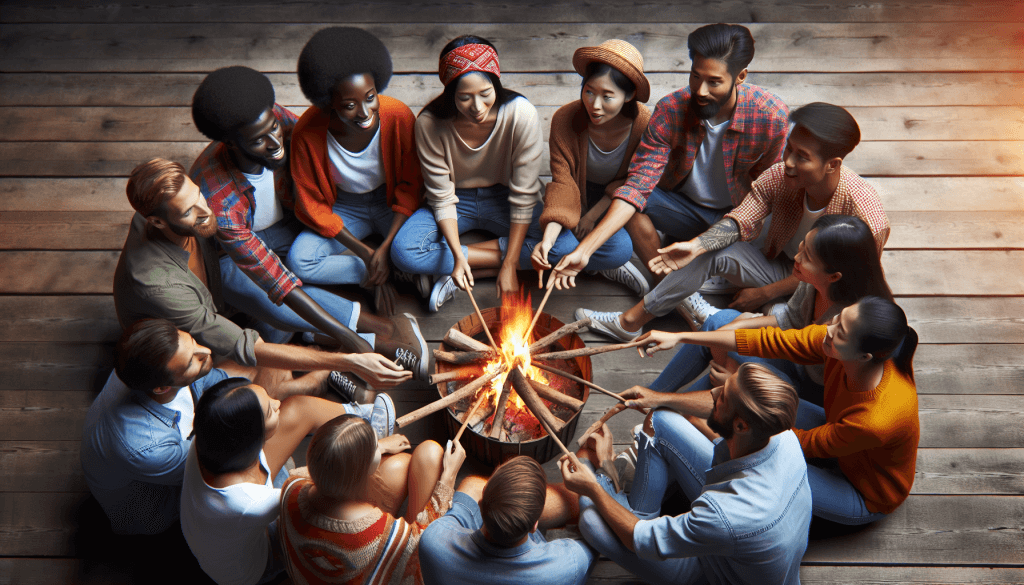Building stronger connections often starts with shared experiences. Whether it’s laughing over a silly mistake, working together on a challenging project, or simply enjoying a quiet moment, these shared moments create bonds that are hard to break. They’re the glue that holds relationships together, whether in personal life, at work, or within communities. But why do shared experiences matter so much, and how can we use them to build meaningful connections? Let’s dive in.
Key Takeaways
- Shared experiences are powerful tools for building trust and understanding in relationships.
- They enhance teamwork, foster empathy, and create lasting memories.
- Intentional activities like rituals, skill-sharing, and cultural celebrations can strengthen bonds.
- Leadership and community involvement amplify the impact of shared experiences.
Introduction to Building Stronger Connections Through Shared Experiences
Importance of shared experiences in fostering relationships
Think about your closest relationships. Chances are, they’re built on a foundation of shared experiences—those moments that make you laugh, cry, or simply feel understood. These experiences create a sense of belonging and help people feel connected on a deeper level.
Shared experiences are like bridges. They connect people, even if they come from different backgrounds or have different perspectives. They foster trust, empathy, and understanding, which are essential for any healthy relationship.
Role of shared experiences in enhancing team dynamics
In a team setting, shared experiences can transform a group of individuals into a cohesive unit. Whether it’s a team-building retreat, a brainstorming session, or a simple coffee break, these moments create a sense of camaraderie.
When people work together and share experiences, they’re more likely to communicate openly, support each other, and work towards common goals. This is why many organizations prioritize activities that bring their teams together.
Overview of the benefits of shared experiences
The benefits of shared experiences go beyond just feeling good. They can improve mental health, boost productivity, and even strengthen communities. They help people feel seen, heard, and valued, which is essential for building strong, lasting connections.

Unique Shared Experiences as a Framework for Connection
Rapid relationship-building through unique activities
Sometimes, all it takes is one memorable experience to form a strong connection. Activities that are out of the ordinary—like escape rooms, cooking classes, or even virtual reality games—can bring people together quickly.
These activities create a sense of novelty and excitement, which makes them more memorable. They also encourage teamwork and communication, which are key ingredients for building relationships.
Examples of modern shared experiences
Virtual coffee chats
In today’s digital world, virtual coffee chats have become a popular way to connect. These informal video calls allow people to bond over casual conversations, even if they’re miles apart.
Shout-out sessions
Shout-out sessions are another great way to create shared experiences. These are moments where team members recognize each other’s contributions, fostering a sense of appreciation and camaraderie.

Personal and Team Connection Rituals
Strengthening interpersonal bonds through rituals
Rituals are like anchors. They provide stability and create a sense of continuity in relationships. Whether it’s a weekly family dinner, a monthly team meeting, or a daily check-in, rituals help people stay connected.
Examples of effective rituals
Virtual coffee chats for informal bonding
Virtual coffee chats aren’t just for teams—they’re great for personal relationships too. They’re a simple way to catch up and share moments, even if you’re far apart.
Shout-out sessions for team recognition
Shout-out sessions can be adapted for personal relationships as well. For example, families can have a “gratitude circle” where everyone shares something they appreciate about each other.

Skill-Sharing and Learning-Based Activities
Promoting collaboration through knowledge exchange
Learning together is a powerful way to build connections. When people share their skills and knowledge, they not only help each other grow but also create a sense of mutual respect and admiration.
Examples of skill-sharing activities
Lunch & learn sessions
Lunch & learn sessions are a fun way to combine food and learning. These informal gatherings allow people to share their expertise while enjoying a meal together.
Peer-led workshops
Peer-led workshops are another great option. These sessions encourage collaboration and give everyone a chance to contribute.

Leadership-Inclusive Activities
Enhancing connection and transparency through leadership involvement
When leaders participate in shared experiences, it sends a powerful message. It shows that they value connection and are willing to invest time in building relationships.
Examples of leadership-inclusive activities
Meet-the-CEO coffee chats
These informal chats give employees a chance to connect with their leaders on a personal level. They’re a great way to build trust and transparency.
Executive storytelling sessions
Storytelling sessions allow leaders to share their experiences and insights, creating a sense of connection and inspiration.

Cultural Connection and Inclusion Activities
Celebrating diversity to foster belonging
Diversity is a strength, and celebrating it can bring people closer together. Activities that highlight different cultures and traditions create a sense of inclusion and belonging.
Examples of cultural connection activities
InclusiviTea sessions
InclusiviTea sessions are gatherings where people share tea and stories from their cultures. They’re a simple yet powerful way to celebrate diversity.
Culture spotlight days
Culture spotlight days allow people to showcase their traditions, food, and music, creating a rich tapestry of shared experiences.

Community and Social Impact Activities
Encouraging teamwork through social impact initiatives
Giving back to the community is a great way to build connections. When people work together for a common cause, they create a sense of purpose and unity.
Examples of community-focused activities
Volunteer days
Volunteer days allow teams to work together on community projects, such as cleaning up a park or serving meals at a shelter.
Donation match drives
Donation match drives encourage people to contribute to a cause, knowing their efforts will be matched by their organization.
Connection as a Cultural Priority
The role of shared experiences in creating an engaged workforce
Organizations that prioritize shared experiences often have more engaged and motivated employees. These experiences create a sense of community and make people feel valued.
Long-term benefits of prioritizing connection in organizations
The benefits of shared experiences extend beyond the workplace. They create a ripple effect, strengthening relationships and communities. By prioritizing connection, organizations can create a culture of trust, empathy, and collaboration.
For more insights on fostering relationships, check out this guide on building healthy relationships.
Conclusion
Recap of the importance of shared experiences
Shared experiences are the foundation of strong relationships. They create trust, foster empathy, and bring people closer together. Whether it’s a simple coffee chat or a grand cultural celebration, these moments matter.
Call to action for individuals and organizations to embrace shared experiences
So, what are you waiting for? Start creating shared experiences today. Whether you’re planning a team-building activity, a family ritual, or a community project, remember that every moment counts.
Looking for more ways to connect? Explore strategies for building and maintaining strong friendships or learn about the impact of staying connected with a supportive community.
Let’s build stronger connections, one shared experience at a time.

FAQ: Building Stronger Connections Through Shared Experiences – Discover the Power of Togetherness!
What does it mean to build stronger connections through shared experiences?
Building stronger connections through shared experiences involves engaging in activities or moments with others that foster mutual understanding, trust, and emotional bonds. These shared moments create lasting memories and deepen relationships by emphasizing common interests and values.
Why are shared experiences important for relationships?
Shared experiences are crucial because they create opportunities for emotional connection and mutual growth. They help individuals understand each other better, build trust, and establish a sense of belonging, which are all essential for healthy and meaningful relationships.
What are some examples of shared experiences that strengthen connections?
Examples include traveling together, participating in team sports, collaborating on a project, attending events, or even simple activities like cooking or watching a movie together. The key is to engage in activities that both parties find enjoyable and meaningful.
Can shared experiences improve communication?
Yes, shared experiences often lead to better communication by creating a safe space for open dialogue. They encourage individuals to express themselves, share thoughts, and listen actively, which strengthens understanding and reduces misunderstandings.
How can shared experiences help in resolving conflicts?
Shared experiences can help resolve conflicts by shifting focus from disagreements to common goals or enjoyable activities. They foster empathy and remind individuals of their shared bond, making it easier to address issues constructively and collaboratively.
Are shared experiences only beneficial for romantic relationships?
Not at all! Shared experiences are beneficial for all types of relationships, including friendships, family bonds, and professional connections. They help build trust, camaraderie, and a sense of unity in any relationship context.
How can I create shared experiences if I have a busy schedule?
Even with a busy schedule, small moments like sharing a meal, having a quick conversation, or engaging in a short activity together can create meaningful shared experiences. Prioritizing quality over quantity is key to making the most of limited time.
What role does vulnerability play in shared experiences?
Vulnerability allows individuals to open up and share their authentic selves during shared experiences. This openness fosters deeper emotional connections and trust, making the shared moments more impactful and meaningful.
Can virtual shared experiences be as effective as in-person ones?
While in-person experiences often feel more tangible, virtual shared experiences can also be effective. Activities like video calls, online games, or virtual events can help maintain connections, especially when physical distance is a barrier.
How can shared experiences contribute to personal growth?
Shared experiences often push individuals out of their comfort zones, exposing them to new perspectives and challenges. This not only strengthens relationships but also promotes personal growth by encouraging adaptability, empathy, and self-awareness.



